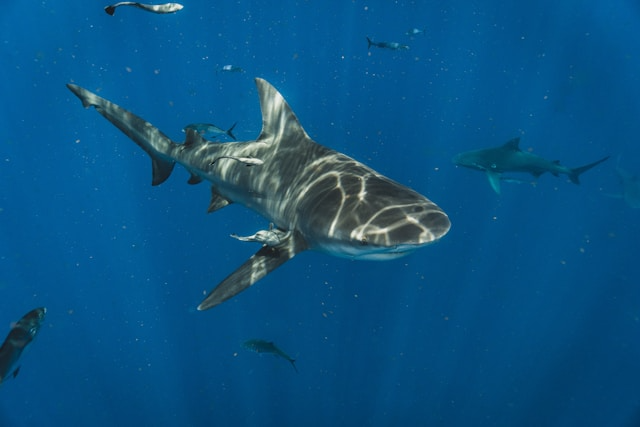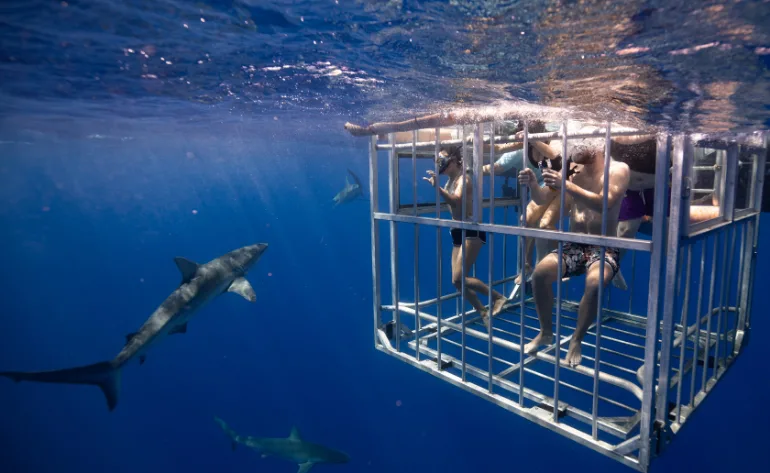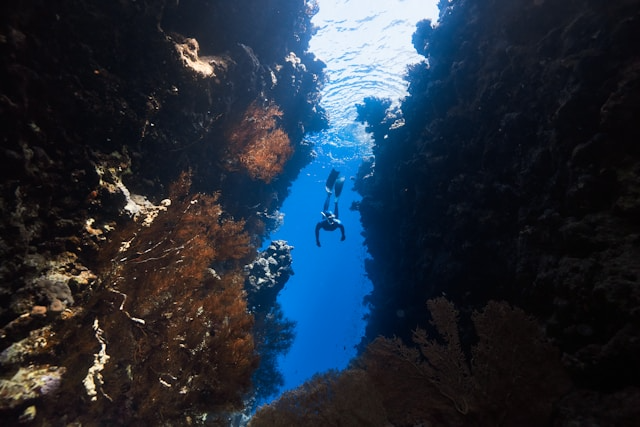Hawaii is not just about seeing all the beautiful things around you; it’s also about experiencing unique things with your loved ones. So, are you looking to experience something unique? Have you ever dreamt of locking eyes with a shark? If yes, then you’re not alone.
Think about diving underwater in a shark cage, which is a truly nerve-wracking experience that brings a human face-to-face with one of nature’s deadliest predators while keeping you and the shark safe.
Nowadays, or let’s say after the release of the popular shark movie Jaws in the mid-1970s, shark cage diving has become one of the top activities on the bucket list in Hawaii, specifically on Oahu’s North Shore. But is it as safe as it sounds?
Let’s dive into everything you need to know about how safe is shark cage diving in Hawaii.
What is Shark Cage Diving?
Hawaii includes many species of sharks and crystal-clear waters surrounding the islands, which makes it an excellent place to see these sharks close up.
A shark cage dive is an adventurous activity in which individuals enter a metal cage, which would be lowered into the ocean.
The cage generally keeps the participants physically separated from the sharks but allows them a clear view of these beautiful creatures in their own habitat.

Types of Sharks You’ll See in Hawaii
In general, the shark encounters you will have on Hawaii’s shores are mainly the curious and non-aggressive types. The reason could also be that most of the time, the tour operators will take you to areas known for sharks, like Galapagos Sharks, Sandbar Sharks, and sometimes even Tiger Sharks.
Now, if you ask us what types of sharks you’ll see, well, we can’t really say a number. There are almost more than 40 types of sharks you can see in the Hawaiian waters. These sharks can range in size from 8 inches to 50 feet and more.
Apart from those that we already mentioned, some of the most common ones you can see near the shore are the whitetip reef, sandbar, scalloped hammerhead, and tiger.
Shark Cage Diving in Hawaii: Safety Record
All the companies, including ours that operate shark dives in Hawaii follow rigorous safety protocols. They’re regulated and required to maintain high safety standards. Here’s a look at some safety elements we add to make the activity even more secure.
The Cage Itself
Shark diving cages are made so that if you’re inside, you’ll be able to observe sharks, yet you’ll be protected and not be too close to them.
These shark cages are made of very hard metallic bars, requiring strict inspection and maintenance. It can be really a big challenge for sharks to break through, as the design and durability are commendable.
Experienced Staff and Guides
Dive operators in Hawaii have experienced guides who are well familiar with shark behavior and safety precautions.
These guides will give you enough pre-dive briefings regarding everything from what you are expecting to how you should keep yourself in the cage.
They know the waters and the behavior of the local shark species, so they’ll most likely anticipate and then react in time to ensure your safety.
Strict Operating Procedures
Hawaii’s regulations regarding shark diving are pretty strict. The operators are very mindful of the sharks’ well-being and that of the marine ecosystems of the place.
Thus, they ensure the activity will not cause any harm to the sharks or interfere with their habitat in any way, including time limitations and a number of divers per day.

Types of Shark Diving
You may now have an idea of what this activity is all about. While the tour companies do almost everything to protect the participants for a safe cage diving session and to make shark tourism exciting, there are still some risks related to the activity. There are different types of shark diving activities, each sure to bring a different level of fun but also some risks. Some examples of diving with sharks activities are:
Open-water Shark Diving
In this activity, you literally get to dive open water with no cage or snorkel barrier between you and those sharks. You can observe them close to some distance or interact with sharks.
It is generally one of the riskier ways to dive with sharks, as you’re fully exposed and far from quick access to first aid.
Even so, it can be a pretty safe and incredibly exciting experience if it’s managed with proper safety precautions and by experienced guides.
Shark Feeding Dives
These dives attract sharks to a particular location by chumming the water or using bait, then feeding them by hand or from a bait box.
When this gets very intense, the sharks begin associating the humans with food sources and become much more aggressive during encounters, leading to more frequent and intense incidents, including bites and fatalities, by tiger sharks and other species.
Bull and Tiger Shark Dives
Bull Sharks and Tiger Sharks are some of the most aggressive shark species, so dives that focus on them can sometimes be quite dangerous in terms of shark diving compared to other dives.
However, with proper safety and diving equipment and good guides, most find dives with these animals relatively safe for themselves.

Common Safety Concerns about Shark Cage Diving
Now that we know the types, structure, and protocols, let’s address some common fears and whether they’re realistic.
Concern #1: What if a Shark Attacks the Cage?
While movies might make it look like sharks always want to break the cage down and get inside, the fact remains that this creature is usually curious. That cage framework is so strong that it’s almost impossible to damage the shark.
Sharks don’t look at the cage as their prey but something they’re just curious about. So, they may just swim up, glaze around, and then swim away. Actual aggression is rare.
Concern #2: Are There Dangerous Conditions in Open Waters?
Hawaii’s shark diving sites are chosen for their safety, meaning calm waters with great visibility. In open ocean waters, there is always a degree of unpredictability, but shark diving companies check conditions and will cancel trips if the water is too rough or visibility is low.
Concern #3: What if Something Goes Wrong?
Crews on shark diving tours are trained for emergency situations and carry the necessary equipment, such as oxygen tanks and first-aid kits.
Most tour operators also have plans in place for evacuations and other emergencies. To top it all off, many of these dive sites are but a short distance from shore, so help is readily at hand if there ever is any trouble.
Concern #4: Is it Ethical?
Most people ask the question: Does shark cage diving harm the animals or disrupt their behavior? Frankly, responsible operators in Hawaii are bent toward the eco-friendly route, and their prime focus is on education and conservation rather than on scaring the sharks.
They want people to know more about sharks, which would help towards a better understanding of the wild animals in this marine ecosystem. So, yes, shark cage diving is ethical!
Are there Any Benefits of Shark Diving?
Diving with sharks actually packs a punch in the conservation world—and it’s not just about the adrenaline rush. There are some very real ways shark diving helps protect these incredible creatures and their underwater homes.
First up, promoting ecotourism. By offering shark diving experiences, ecotourism operators bring in revenue that directly supports shark conservation and habitat protection. It’s a win-win: people get the thrill of a lifetime, and local communities get an economic reason to keep sharks swimming rather than, well, on the menu.
Then there’s public awareness. Diving with sharks has a funny way of transforming even the most indifferent tourists into shark fans. These dives reveal sharks as much more than the “monsters” of myth, helping people see them as vital parts of the ocean’s health—and making people a lot more sympathetic to the challenges sharks face, from overfishing to accidental capture.
Now for the science crowd: research opportunities. Shark dives and even top-side viewings are invaluable for scientists studying shark behavior, population dynamics, and habitat use. These dives give researchers a chance to gather data that will directly inform conservation efforts.
Finally, responsible behavior. Divers get schooled in the finer points of hands-off interaction: no touching, no feeding, and respecting their space like they’re royal guests. It’s an “etiquette class” for marine life appreciation, reminding divers that we’re just visitors in the underwater world, and we should leave it exactly as we found it.

Tips to Make the Most of Your Shark Diving Experience
There are a few things you need to follow in order to make your diving experience safe and fun:
Pay attention to the instructions: The guides have years of experience with sharks and know what is best for you. Therefore, you should pay special attention to listening to instructions about shark behavior while inside the cage.
Avoid wearing flashy jewelry: Sharks are attracted to shiny reflective things that look like fish scales. It’s best to leave the flashy jewelry at home.
Keep your hands inside: No matter how safe the cage is, make sure all limbs stay inside to avoid accidental touching of sharks.
Bring a waterproof camera: Most operators allow you to bring along waterproof cameras to capture unforgettable shots. Just ensure it is well secured!
Relax and have fun: Sharks will pick up on whether you’re nervous. If you take your time learning to relax and let yourself have fun, the dive will go much smoother.
FAQs
Is shark cage diving safe?
Yes, shark cage diving is generally considered safe when conducted by reputable, licensed operators who follow strict safety guidelines.
Are sharks dangerous during a cage dive?
While sharks are powerful animals, they are generally more curious than aggressive. Sharks may approach the cage out of curiosity, but they cannot reach the divers inside.
Do I need to be a certified diver to go shark cage diving?
No scuba certification is required. Some tours use air supply hoses or keep the cages just below the surface, allowing non-certified divers to participate safely. Check with your tour provider about any requirements they may have.
Final Thoughts: Is Shark Cage Diving Safe?
Yes, shark cage diving is a safe experience in Hawaii, provided you opt for the right company. This activity is indeed a remarkable and unique way to interact with marine life, connect with sharks, become more aware of them, and support their conservation.
Just remember to follow the given safety protocols and understand what a shark sighting will look like. Once you abide by the rules, you’re sure to have a memorable adventure that is both exhilarating and educational. And you might just stroll out of the cage with a newfound favorite animal and a couple of great stories to tell.
